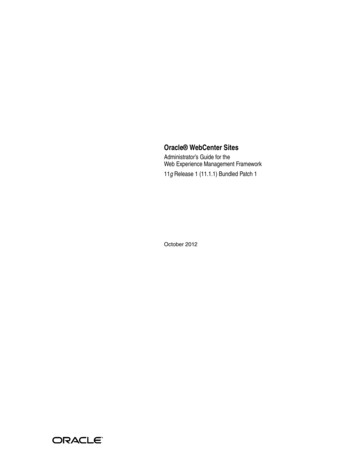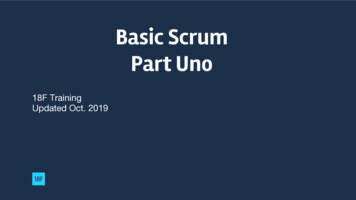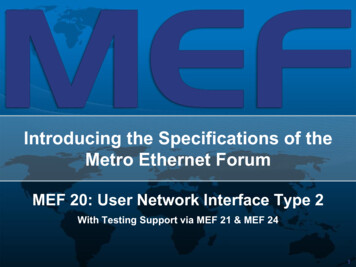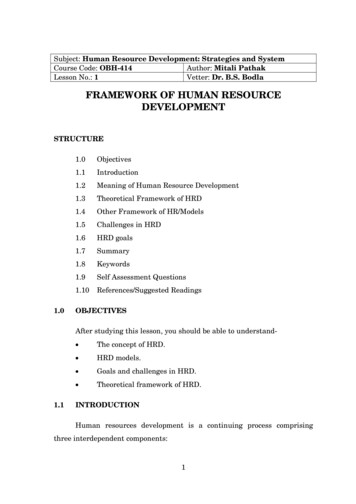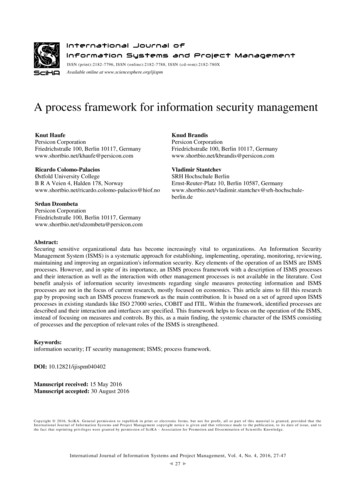
Transcription
ISSN (print):2182-7796, ISSN (online):2182 -7788, ISSN (cd-ro m):2182-780XAvailable online at www.sciencesphere.org/ijispmA process framework for information security managementKnut HaufePersicon CorporationFriedrichstraße 100, Berlin 10117, Germanywww.shortbio.net/khaufe@persicon.comKnud BrandisPersicon CorporationFriedrichstraße 100, Berlin 10117, do Colomo-PalaciosØstfold University CollegeB R A Veien 4, Halden 178, f.noVladimir StantchevSRH Hochschule BerlinErnst-Reuter-Platz 10, Berlin 10587, hschuleberlin.deSrdan DzombetaPersicon CorporationFriedrichstraße 100, Berlin 10117, ract:Securing sensitive organizational data has become increasingly vital to organizations. An Information SecurityManagement System (ISMS) is a systematic approach for establishing, implementing, operating, monitoring, reviewing,maintaining and improving an organization's information security. Key elements of the operation of an ISMS are ISMSprocesses. However, and in spite of its importance, an ISMS process framework with a description of ISMS processesand their interaction as well as the interaction with other management processes is not available in the literature. Costbenefit analysis of information security investments regarding single measures protecting information and ISMSprocesses are not in the focus of current research, mostly focused on economics. This article aims to fill this researchgap by proposing such an ISMS process framework as the main contribution. It is based on a set of agreed upon ISMSprocesses in existing standards like ISO 27000 series, COBIT and ITIL. Within the framework, identified processes aredescribed and their interaction and interfaces are specified. This framework helps to focus on the operation of the ISMS,instead of focusing on measures and controls. By this, as a main finding, the systemic character of the ISMS consistingof processes and the perception of relevant roles of the ISMS is strengthened.Keywords:information security; IT security management; ISMS; process framework.DOI: 10.12821/ijispm040402Manuscript received: 15 May 2016Manuscript accepted: 30 August 2016Copyr ight 2016, SciKA. General per missio n t o repu blish in pr int or elect ronic forms, but not for profit , all or part of t his mat er ial is grant ed, provided t hat t heInt ernat ional Jour nal o f I nfor mat io n S yst ems and Pro ject Manage ment copyr ight notice is given and t hat reference made t o t he publicat ion, t o it s dat e of issue, and t ot he fact t hat reprint ing pr ivileges were grant ed by per miss io n o f SciKA - Associat ion for Pro mot ion and D isseminat io n o f Scient ific Knowledge.International Journal of Information Systems and Project Management, Vol. 4, No. 4, 2016, 27-47 27
A process framework for information security management1. IntroductionInformation security is an integral element of fiduciary duty. The purpose of information security is to protect anorganization’s valuable resources, such as information [1]. Information security is also identified as a subset ofInformation Technology (IT) governance [2]. In relevant standards and frameworks as well as in the scientific literature,the continuously increasing dependency of nearly all organizations on appropriate secure information processing wasstated practically in the last years [3]–[5]. Standards for the management of information security and collections of bestpractice measures were developed and established in the literature, e.g. [6]. Important standards for the developmentand operation of an ISMS (hereinafter referred to as “ISMS”) are the ISO 27000 series.Over the last few years, cost benefit discussions have influenced information security practice [7]. The value ofinformation must justify protection costs. Adjustment and cost-effectiveness are key elements of a successful ISMS [1].Knowledge of the mission is needed to align the ISMS processes to the organization and its mission [8].Taking into account that business alignment and cost-effectiveness are important for the successful operation of anISMS, research contributions must address both problems by allowing the simplification of the identification ofnecessary and appropriate ISMS processes as core elements of every ISMS.IT and its management are also some of the hot topics for practitioners and researchers alike [9]–[11]. In a scenario, inwhich security management has also been pointed out as one of the most important topics in the discipline, there is nospecific process framework for security management which clearly differentiates between ISMS processes and of thesecurity measures controlled by ISMS-processes. Furthermore, a detailed description of ISMS processes and theirinteraction as well as the interaction with other management processes – as already identified in [12] – does not exist.This problem is further exasperated because information security management is a complex issue [13]. Current researchactivities focus on economics and cost benefit analysis of information security investment regarding single measuresprotecting information. The ISMS and the ISMS processes themselves are not in the focus of current research [14]–[16]. So, such a holistic but detailed framework of ISMS core processes as core elements of every ISMS needs to bedeveloped.This specific process framework for security management needs to clearly differentiate between ISMS core processes,supporting processes and management processes, as well as the security measures controlled by ISMS-processes.Adjustment and cost-effectiveness are key elements of a successful ISMS [1]. A detailed framework of ISMS processes(input, output, interfaces) and their interaction at an activity level help to ensure an appropriate interaction of the ISMSprocesses. To fill this research gap, in this paper a holistic but detailed framework of ISMS core processes as coreelements of every ISMS is proposed.The remaining of this paper is structured as follows: in section 2 authors give an overview of the most relevantstandards on the topic. In section 3 authors describe the applied research methods and in section 4 authors illustrate theproposed ISMS process framework and discuss the contained processes. Section 5 gives an overview of the results fromthe evaluation of the framework. Section 6 summarizes the main findings and gives an outlook on future researchactivities.2. BackgroundIn relevant standards and frameworks as well as in the literature, the continuous increasing dependency of nearly allorganizations on appropriate secure information processing was stated [17]–[19]. Standards for the management ofinformation security and collections of best practice measures were developed and established [5], [20]–[22]. Besidenational standards like NIST SP 800 series in the US [23] or the IT security guidelines from the Federal Office forInformation security in Germany [22], the most important standards for the development and operation of an ISMS areInternational Journal of Information Systems and Project Management, Vol. 4, No. 4, 2016, 27-47 28
A process framework for information security managementthe ISO 270xx, ITIL and COBIT [24]. The same standards were identified in an ISACA study [25, p. 26] as most usedstandards for IT governance and IT management, followed by CMM and CMMI, PRINCE2 and PMBOK.2.1 ISO 27000 seriesThe International Organization for Standardization (hereinafter referred as “ISO”) and the International ElectrotechnicalCommission (hereinafter referred as “IEC) formed a joint technical committee – ISO/IEC JTC 1. The sub-committeeSC 27 of this committee has a working group WG 1 which develops and facilitates international standards for ISMSs.ISO 27001 as the international standard from ISO/IEC JTC 1 SC27 WG1 for information security management systems(herein after referred as “ISMS”) is the security standard in enterprises [20], [26].ISO 27001 contains the requirements for planning, implementing, operating, and improving an ISMS. Requirements areformulated in a general manner to fit for all organizations independent of their size, objectives, business model location,et cetera. In ISO 27001 absolutely no requirements are formulated for any specific technology [27] but the standardcontains requirements for ISMS core process. Therefore, this standard forms the basis to identify ISMS core processes.The ISO 27000 series do not only contain ISO 27001. Another common standard for information security of the ISO27000 series is ISO 27002 [21], containing controls that should be implemented with the ISMS. ISO 27002 is linkedwith ISO 27001 with an Annex of ISO 27001 listing the controls of ISO 27002. Further ISO 27000 series standards are: ISO 27000 – ISMS – Overview and vocabulary;ISO 27003 – ISMS implementation guidance;ISO 27004 – Information security management – Measurement;ISO 27005 – Information security risk management;ISO 27006 – Requirements for bodies providing audit and certification of ISMS;ISO 27007 – Guidelines for ISMS auditing;ISO 27008 – Guidance for auditors on ISMS controls;ISO 27010 and following – sector specific standards;ISO 27030 and following – standards for technical controls and guidelines for controls of ISO 27002.2.2 ITILThe IT Infrastructure Library (ITIL), specified in [28]–[33], is a best practice framework for IT service management. ITservice management is the management of all processes that co-operate to ensure the quality of live IT services,according to the levels of service agreed with the customers [34]. The primary objective of service management is toensure that IT services are aligned to the business needs and actively support them [28]. ITIL was developed by theCentral Computing and Telecommunications Agency – today Office of Government Commerce – and is today availablein the third version. ITIL contains five books: Service strategy [32] – is a guideline for designing and implementing service management as strategic asset.Service strategy ensures the management of costs and risks of the service portfolio. While not only focusing onoperational efficiency, it also ensures holistic and sustainable services; Service Design [28] – provides instructions for the development and design of services and processes. Designprinciples and methods are presented to transform strategic goals in a portfolio of services and service assets; Service Transition [33] – contains information about the development and improvement of capabilities regardingthe implementation of new or changed services into production; Service Operation [31] – is focusing on the operation of IT services regarding efficiency and effectiveness; Continual Service Improvement [29] – contains instructions for the recurring improvement of design,implementation and operation of IT services (continual improvement process).ISO/IEC 20000 [35], [36] is the international standard for service management containing the requirements of a servicemanagement system while ITIL provides a body of knowledge for achieving those requirements [28].International Journal of Information Systems and Project Management, Vol. 4, No. 4, 2016, 27-47 29
A process framework for information security management2.3 COBITControl Objectives for Information and related Technology (COBIT), specified in [37]–[40] is a control framework tohelp an organization ensure alignment between use of information technology and its business goals [41]. COBIT isbased on five key principles [37]: Meeting stakeholder needs; Covering enterprise end-to-end; Applying a single,integrated framework; Enabling holistic approach; Separating governance from management.COBIT also contains a process reference model, generic process capability attributes and a process assessment modelwhich describes how to execute a capability assessment in an efficient and effective way. COBIT will be analyzed withthe aim to use or adapt the process reference model for the use with ISMS core processes. Furthermore a COBIT 5Professional Guide for Information Security [40] is provided which focusses on information security and provides moredetailed and more practical guidance.Mappings and integrations between/of COBIT, ITIL and ISO/IEC27000 series are available [42], [43]. In this article,the COBIT family is used to identify ISMS core processes and to integrate maturity levels in the ISMS core processframework.3. Research methodsAccording to Susanto et al. [44] the most important and most widely accepted international initiatives for thedevelopment and operation of an ISMS are ISO 27000 series, ITIL [28]–[33] and COBIT [38]. These initiatives are alsorelevant in aspects like information and security management [10]. To obtain an agreed basis of ISMS processes ofthese standards, multiple process reference models need to be harmonized. To harmonize multiple process referencemodels a systematic stepwise approach presented by Baldassarre [45] was used in a mapping study by Haufe et al. [46].For the analysis of the identified security management standards, an adaptation on the Models and Standards SimilarityStudy method by J. A. Calvo-Manzano et al. [47] was used. The method was as follows:1. Select the models and standards to be analyzed;2. Choose the reference model – as reference model the ISO 27000 series is chosen because resulting from thefocus of this standard series the widest coverage of ISMS processes is expected;3. Select the process;4. Establish a detail level – as all analyzed standards are international standards and are applicable to allorganizations independent of their size, objectives, business model, location, et cetera – the containedinformation about ISMS processes are generic. Therefore, a similar level of detail is chosen to analyze thestandards;5. Create a correspondence template – instead of a detailed correspondence template a process profile templatewas created;6. Identify the similarity among models – the process templates were completed with information obtained fromthe standards;7. Show obtained results.Also the following basic criteria for ISMS core processes were identified and confirmed in a previous study [48] by theauthors: Criteria 1 – Regularity – interrelated and interacting tasks are repeated on a regular basis;Criteria 2 – Transformation – inputs are transformed into outputs;Criteria 3 – Operationally – process is carried out while operating the ISMS;Criteria 4 – Accountability/responsibility – information security officer is the process owner or process managerand the process is a core competency of the ISMS; Criteria 5 – Value generating – delivers apparent and direct value to the stakeholder.International Journal of Information Systems and Project Management, Vol. 4, No. 4, 2016, 27-47 30
A process framework for information security managementFor the identification of processes, the following method was used:1. Initially the ISO 27000 series were analyzed regarding mentioned processes;2. ITIL and COBIT were analyzed (matching) regarding ISMS processes which were already identified in theISO 27000 series as well as regarding additional possible ISMS processes. A matching table regarding thepossible ISMS processes was created for ITIL and COBIT [46]. In the context of the matching the followingquestions were asked (based on Calvo-Manzano et al. [47]):a. Is there any information about ISMS processes in the other standards related to ISMS processes of thereference standard (ISO 27000 series)? What is the additional information that could help to carry outthe ISMS process of the reference standard?b. Is there any information about possible additional ISMS processes in the other standards? What is thisinformation/what is the possible additional ISMS process?3. The results from steps one and two were summarized in a mapping table which is documented in Haufe et al.[46].The detailed approach of the mapping study is also described in Haufe et al. [46].4. Process FrameworkAs a result of the mapping study the following processes were identified as ISMS processes:Table 1. ISMS processesProcess/criteriaProcess categoryProcess/criteriaProcess categoryISMS planning processManagement processInformation security governance processManagement processInformation security risk assessment processISMS core processInformation security risk treatment processISMS core processResource management processISMS core processProcess to assure necessary awareness and competenceISMS core processCommunication processISMS core processDocumentation and records control processISMS core processRequirements management processISMS core processInformation security change management processISMS core processProcess to control outsourced processesISMS core processPerformance evaluation processISMS core processInternal audit processISMS core processInformation security incident management processISMS core processInformation security improvement processISMS core processInformation security customer relationship management processISMS core processConfiguration management processSupport processInternational Journal of Information Systems and Project Management, Vol. 4, No. 4, 2016, 27-47 31
A process framework for information security managementISMS processes and their interaction at a high level basis are shown in Fig. 1. ISMS process framework. Someinterfaces are not illustrated to enable a better readability of Fig. 1. ISMS process framework: Every ISMS processprovides input for the documentation and records control process; The ISMS planning as well as the configurationmanagement process provide input for every ISMS process.ManagementprocessesISMS core processesDocumentation andrecords control process(documentation of theoutput of the processes)ISMS planningprocess (providesinput for the ISMSprocesses)Changed requirements, list of requirementsApplicable requirementsRequests for Changes and change results/statusReports regarding resource usage for ISMS controlsResults of changesProposed changes and evaluated risks of proposed changesRequests for ChangesResource usage ementsIncidentsInformationsecurity requirementsResourcemanagementprocessEstimation ofnecessaryresourcesto implementcontrolsSelected controlsInformationsecurity tedrisksIncidentsRequests for ChangesInformationsecurity risktreatmentprocessRisk treatment plan,controls, control ests for sProcesses toassurenecessaryawarenessApplicable requirementsIncident reportsAudit results (Information about potential incidents)Request for changes(to correctnonconformities)Internal auditprocessNot continuouslymeasured metricsInformation securitycustomerrelationshipmanagement processRequest for changesInformationsecurity changemanagementprocessIncident reportsInformation about potential incidentsPerformance evaluation resultsIncident reportsInformation about (potential) incidentsPerformanceevaluationprocessProcess to controloutsourcedservicesAudit reports forservice provider uggestionsPerformanceevaluationresultsInformation securtiymanagement reportsAuditreportsfor Requestsserviceforprovider ChangesauditsImprovementprocessCommunication planwith customersand reports onInformation securityperformance andadded value to thecustomersSuggestions forimprovementSupport processesConfigurationmanagement processFig. 1. ISMS process frameworkThe ISMS planning process is the process of ISMS specification and design from inception to the production ofimplementation plans. Documentation and records control process is the process to identify, create, update andcontrol information determined to be necessary for the effectiveness of the ISMS.Key to reach the ISMS objectives is an up-to-date understanding of the needs and expectations of interested partiesrelevant to information security and the ISMS. This is realized within the requirements management process, whichInternational Journal of Information Systems and Project Management, Vol. 4, No. 4, 2016, 27-47 32
A process framework for information security managementprovides identified legal, statutory, regulatory and contractual requirements for the risk assessment process, the internalaudit process and the process to control outsourced processes.In the risk assessment process, risks are identified, analyzed and evaluated. The output of this process are documentedand evaluated risks in a list of prioritized risks including threats, vulnerabilities and risk owners, consequences andbusiness impact, likelihood and comparison against risk criteria as well as evaluated risks of proposed changes, whichare input for the communication process and the information security risk treatment process.In the information security risk treatment process risk treatment options including control objectives and controls areidentified and selected. Output of this process are list with selected controls and control objectives, a risk treatment planincluding acceptance of residual risks, a control implementation plan and requests for changes to information securitychange management process, which are used as input in various ISMS processes.Resources needed to implement the controls as well as to run the ISMS processes are identified, allocated andmonitored in the resource management process. Output of the resource management process are planned/documentedresources to implement and run selected controls, categorization of controls regarding who funds the control, plannedand documented resources to run the ISMS core processes, reports regarding resource usage of ISMS core processes,and for the information security customer relationship management process: reports on resource usage. Theimplementation of controls always results in changes, which can be managed within a general change managementprocess of the implementing organization or – if the change focuses on an ISMS element – within the informationsecurity change management process. The information security change management process is the process to controlchanges of ISMS elements and review the consequences of unintended changes. This process only focusses on changemanagement of the ISMS. Output of this process are necessary changes (for documentation and records controlprocess), proposed and necessary changes as well as results of changes (for and from risk assessment process), initiationof risk assessment when significant changes are proposed or occur and the results of changes to information securityincident management process, as they were initiated by that process.The information security incident management process is for detecting, reporting, assessing, responding to, dealingwith and learning from information security incidents. Output of this process are identified incidents which are used invarious ISMS processes including the information security change management process and the process to ensurenecessary awareness.In the information security awareness process an information security awareness, training and education program isdeveloped and implemented to ensure that all personnel receive the necessary security training and/or education.As services are outsourced, these services need to be determined and controlled, which is realized within the process tocontrol outsourced services.The performance evaluation process contains monitoring, measurement, analysis and evaluation of two main criteria.First, the performance of the security controls and second the performance of the ISMS processes. Performancemeasurement differs from performance audit (internal audit) regarding effectiveness and efficiency of the ISMS andimplemented controls which is performed independently within the internal audit process.Results from the performance evaluation process, the internal audit process as well as results from the service provideraudits from the process to control outsourced services are used to improve effectiveness, efficiency, suitability andadequacy of the ISMS and the controls. This is realized within the information security improvement process.Results of nearly all ISMS processes are centrally communicated within the communication process to stakeholdersoutside the ISMS. This includes the communication of risks and information security management reports. Thosereports as well as identified requirements are input for the information security governance process, which ensures analignment of the ISMS with the objectives and needs of the governing stakeholders.Beside the information security governance process, which forms the interface between the ISMS and its stakeholders,the operational management of the customer satisfaction level as well as the continuous demonstration of the addedInternational Journal of Information Systems and Project Management, Vol. 4, No. 4, 2016, 27-47 33
A process framework for information security managementvalue of investments in information security need to be realized. This is done within the information securitycustomer relationship management process.The ISMS processes are discussed in more detail in the following subsections.4.1 ISMS planning processIn the ISMS planning process, inputs like the vision of the stakeholders are transformed into outputs like themanagement approval for the ISMS or the ISMS scope. Some of the outputs of this process – like managementapproval, scope definition – need to be checked in a regular basis regarding their actuality and appropriateness, but theprocess itself is primary an initial process which is carried out once as a project [49, p. 5]. The regular activities likerenewing the management approval are also integrated in the management review and improvement processes. TheISMS planning process is clearly a process of the plan phase in the Plan Do Check Act (PDCA) cycle which means thatthe process is not carried out while operating the ISMS (DO phase).The ISMS designing process is value generating for the top management while it builds the basis for establishing theISMS, provides objectives for the ISMS and ensures an ISMS which fulfills the requirements of the top management.4.2 Information security governance processInformation security governance from a holistic perspective is required to cultivate an acceptable level of informationsecurity culture and minimizing information security risks [50]. The management should initiate management reviewsto continually improve the suitability, adequateness and effectiveness of the ISMS [20, p. 9]. Output of the managementreview contains decisions related to governing the ISMS. Taking into account the objective to governing the ISMS, theinformation security governance process must be repeated on a regular basis.Inputs like management reports are transformed into decisions related to the governance of the ISMS and related changerequests.The information security officer is operationally involved in the process with compiling and presenting managementreports. This process is carried out to govern the ISMS. Therefore, it is not a process of the operationally level.However, the owner of this process is the top management, as top managers are responsible to initiate the reviewprocess and to provide objectives and requirements to manage the ISMS. Information security governance processobjectives for the ISMS are defined and the achievement of the information security objectives are monitored at ageneral level. However, top managers review and decide relevant aspects on this process.Results of this process like informed and efficient management decisions represent a direct value for the topmanagement (stakeholders) as they ensure that the ISMS is operated as intended by the top management and willachieve their objectives as top managers. As a result of this this process is a core competence for top managers.Given the fact that this process is not a core competence of the ISMS and objectives for the ISMS are defined as well asthe achievement of the information security objectives are monitored at a general level, this process is categorized as amanagement process.This process is also part of the service management system. The integration of an ISMS with a service managementsystem enables synergy effects based on the integration of these two processes.4.3 Information security risk assessment processThe information security risk assessment process is the overall process of risk analysis and risk evaluation. Theinformation security risk assessment process should be monitored, reviewed and repeated regularly [51, pp. 22–23].Several iterations of this process are often conducted [51, pp. 9–10]. Inputs from ISMS planning process, informationassets and previous process results are transformed into documented and evaluated risks and risk owners. Theinformation security risk assessment process as part of the information risk management process is an integral part of anInternational Journal of Information Systems and Project Management, Vol. 4, No. 4, 2016, 27-47 34
A process framework for information security managementISMS and should be applied to the ongoing operation of an ISMS [51, p. 3]. The information security risk assessmentprocess is a source of value for the top management while it provides a set of documented risks as well as a documentedevaluation of those risks to help the decision making.Again, this process is also part of the service management system [35, pp. 18–19]. One more time, synergy effectsappear when the integration of ISMS and service management is made possible.4.4 Information security risk treatment processThe information security
COBIT also contains a process reference model, generic process capability attributes and a process assessment model which describes how to execute a capability assessment in an efficient and effective way. COBIT will be analyzed with the aim to use or adapt the process reference model for the use with ISMS core p



